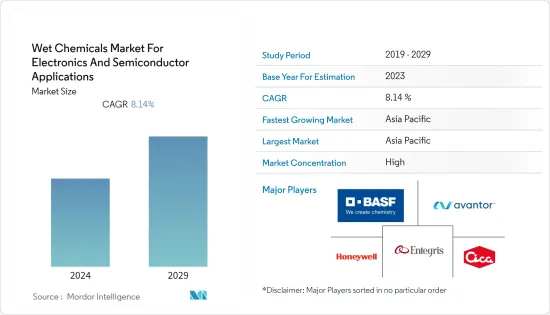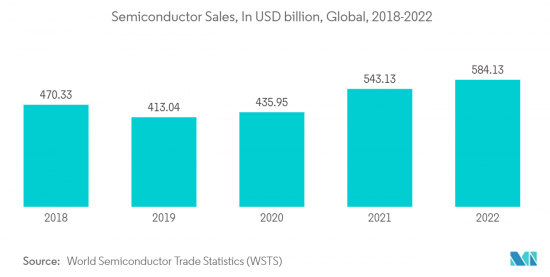 |
市場調查報告書
商品編碼
1404527
用於電子和半導體應用的濕化學品 -市場佔有率分析、行業趨勢和統計、2024-2029 年成長預測Wet Chemicals For Electronics And Semiconductor Applications - Market Share Analysis, Industry Trends & Statistics, Growth Forecasts 2024 - 2029 |
||||||
※ 本網頁內容可能與最新版本有所差異。詳細情況請與我們聯繫。
目前,全球電子和半導體應用濕化學品市場預計為 17.3 億美元,預計未來五年將達到 25.5 億美元,預測期內複合年成長率為 8.14%。

2020 年,電子和半導體應用的濕化學品市場受到 COVID-19 大流行的抑制。然而,電子產業的不斷成長預計將在不久的將來對電子和半導體應用濕化學品市場的需求產生積極影響。
主要亮點
- 從中期來看,市場成長預計將受到半導體產業過氧化氫需求激增以及新興技術驅動的產業需求增加的推動。
- 然而,另一方面,有關半導體廢棄物管理和某些化學品使用的嚴格衛生和環境法規預計將阻礙市場成長。
- 也就是說,馬來西亞的半導體回收和半導體市場的良好成長可能會為所研究的市場創造利潤豐厚的成長機會。
- 亞太地區主導全球市場。預計在預測期內仍將維持最高複合年成長率。
電子濕化學品市場趨勢
半導體應用需求增加
- 濕化學品廣泛用於半導體製造。用於清洗和蝕刻應用。由於人工智慧(AI)、量子計算、5G網路等各種進步的快速成長,半導體產量正在以驚人的速度成長,預計這將在預測期內推動濕化學品市場。 。
- 根據世界半導體貿易統計,2022年全球半導體市場規模達5,800億美元,較2021年的5,558.9億美元成長4.4%。
- 根據半導體產業協會(SIA)的數據,儘管下半年因經濟放緩和通膨而放緩,但2022年全球半導體銷售額仍成長3.2%。
- 該協會的一項研究顯示,到2030年,全球對半導體製造能力的需求預計將增加56%。
- 此外,根據美國創新與競爭法案(USICA),美國政府正在對美國的晶片生產和研究進行大量投資。
- 在北美,美國於2022年8月推出《晶片與科學法案》,支持半導體產業的國內生產與創新。政府宣布將投資520億美元用於晶片製造激勵和研究投資。這包括半導體製造和半導體設備製造的投資稅額扣抵。
- 在亞太地區,印度啟動了一項綜合計劃,以發展其國內半導體和顯示器製造生態系統。政府宣布支出 7,600 億印度盧比(約 100 億美元)。
- 半導體需求的擴張預計將在預測期內推動濕化學品需求。

亞太地區預計將主導市場
- 亞太地區主導全球市場。中國、印度和日本等國家對電子產品的需求增加導致該地區的濕化學品使用增加。
- 中國是全球最大的電子製造基地。智慧型手機、電視和其他個人設備等電子產品在電子產業中成長最快。中國是全球最大的電子設備製造國。中國正積極生產智慧型手機、電視、電線、電纜、可攜式運算設備、遊戲系統和其他個人設備等電子產品。
- 2022年,中國電子市場較2021年成長10%,成長13%。 2023年預計成長率為7%。中國市場是世界上最大的市場,甚至比工業國家市場的總合還要大。 2022年,中國電子產業將成長14%,預計2023年將成長8%。
- 此外,中國是半導體晶片的淨進口國,其生產量不足所用半導體的20%。 2022年國內外市場需求利好,國內101家半導體上市公司公佈年度銷售淨利潤,預示產業濕法化學品向好的方向發展。
- 得益於100%外國直接投資(FDI)、無需工業許可證、技術從手工生產流程向自動化生產流程轉變等優惠政策,印度國內電子製造業正穩步擴張。印度針對國內電子製造業推出了M-SIPS(修改後的激勵特別計畫)和EDF(電子發展基金)等新激勵措施,預算為1.14億美元。
- 印度政府推出的其他促進電子產品生產的計劃包括生產連結獎勵計畫(PLI)、電子元件和半導體製造促進計劃(SPECS)以及改進的電子製造群計劃(EMC 2.0)。隨著印度產量的增加,政府可能會提供獎勵,根據 PLI 計劃,預計到 2025 年印度產量將達到 55 億美元。這可能會在預測期內促進該國電子設備的生產並推動濕化學品市場。
- 印度電子與半導體協會預計,到 2026 年,該國半導體市場價值預計將達到 640 億美元。政府的「印度製造」計畫預計將刺激對該國半導體產業的投資。
- 日本的電氣和電子工業是世界領先的工業之一。日本在電腦、遊戲機、行動電話和其他關鍵零件的生產方面處於世界領先地位。家電佔日本經濟產出的三分之一。然而,由於來自中國、印度和韓國等國家的激烈競爭,日本的電子設備產量正在下降。
- 日本電子情報技術產業協會(JEITA)公佈的資料顯示,2022年日本電子產業總產值約1,11,243億日圓,較上年成長近8%。根據國際貿易局的數據,日本半導體市場規模預計到 2023 年將達到 515.54 億美元,而 2021 年為 436.87 億美元。
- 所有上述因素預計將在預測期內推動亞太地區濕化學品的整體需求。
電子濕化學產業概況
電子和半導體應用濕化學品市場高度集中,五家主要企業佔了60%以上的市場佔有率。市場上排名前五名的公司是Entegris、 BASF SE、Avantor Inc.、Honeywell International Inc.和Kanto Chemical。
其他福利:
- Excel 格式的市場預測 (ME) 表
- 3 個月分析師支持
目錄
第1章簡介
- 調查先決條件
- 調查範圍
第2章調查方法
第3章執行摘要
第4章市場動態
- 促進因素
- 最新技術驅動的產業需求不斷成長
- 半導體產業過氧化氫需求快速成長
- 其他司機
- 抑制因素
- 半導體廢棄物管理
- 關於某些化學品使用的嚴格衛生和環境法規
- 產業價值鏈分析
- 波特五力分析
- 供應商的議價能力
- 買方議價能力
- 新進入者的威脅
- 替代品的威脅
- 競爭程度
第5章市場區隔(市場規模、銷售)
- 產品類別
- 醋酸
- 異丙醇 (IPA)
- 過氧化氫
- 鹽酸
- 氫氧化銨
- 氫氟酸
- 硝酸
- 磷酸
- 硫酸
- 其他產品類型
- 目的
- 半導體
- 清洗
- 蝕刻
- 其他電子應用
- 積體電路 (IC) 製造
- 印刷基板(PCB) 製造
- 半導體
- 地區
- 亞太地區
- 中國
- 印度
- 日本
- 韓國
- 其他亞太地區
- 北美洲
- 美國
- 加拿大
- 墨西哥
- 歐洲
- 德國
- 英國
- 法國
- 俄羅斯
- 其他歐洲國家
- 世界其他地區
- 亞太地區
第6章競爭形勢
- 併購、合資、聯盟、協議
- 市場排名分析
- 主要企業策略
- 公司簡介
- Avantor Inc.
- BASF SE
- Eastman Chemical Company
- Entegris
- FUJIFILM Corporation
- Honeywell International Inc.
- Kanto Kagaku
- Linde PLC
- Solvay
- Songwon
- Technic Inc.
- TNC Industrial Co. Ltd
第7章 市場機會及未來趨勢
- 半導體回收
- 馬來西亞半導體市場穩定成長

The global wet chemicals market for electronics and semiconductor applications is estimated at USD 1.73 billion currently, and it is projected to reach USD 2.55 billion in the next five years, registering a CAGR of 8.14% during the forecast period.
The wet chemicals market for electronics and semiconductor applications was hampered by the COVID-19 pandemic in 2020. However, the rising growth of the electronics industry is expected to positively impact the demand for the wet chemicals market for electronics and semiconductor applications in the near future.
Key Highlights
- Over the medium term, rising demand from industries driven by modern technologies, along with surging demand for hydrogen peroxide from the semiconductor industry, is expected to drive the market's growth.
- However, on the other hand, waste management of semiconductors and stringent health and environmental regulations regarding the use of certain chemicals are anticipated to hinder the market's growth.
- Nevertheless, the recycling of semiconductors and the favorable growth market for semiconductors in Malaysia are likely to create lucrative growth opportunities for the market studied.
- Asia-Pacific dominated the global market. It is also expected to register the highest CAGR over the forecast period.
Electronic Wet Chemicals Market Trends
Increasing Demand Semiconductor Applications
- Wet chemicals are widely used in the production of semiconductors. They are used in both cleaning and etching applications. The production of semiconductors is growing at a staggering pace due to rapid growth from various advancements such as artificial intelligence (AI), quantum computing, and 5G networks, which are estimated to drive the market for wet chemicals during the forecast period.
- According to World Semiconductor Trade Statistics, the global semiconductor market accounted for USD 580 billion in 2022, registering a growth rate of 4.4% compared to USD 555.89 billion in 2021.
- According to the Semiconductor Industry Association (SIA), global semiconductor sales in 2022 rose by 3.2% despite the slowdown in the second half of the year caused by the economic slowdown and inflation.
- According to the survey conducted by the association, the global demand for semiconductor manufacturing capacity is projected to increase by 56% by 2030.
- Moreover, under the United States Innovation and Competition Act (USICA), the US government has made significant investments in chip production and research in the United States.
- In North America, the United States launched the CHIPS and Science Act in August 2022 to support domestic production and innovation in the semiconductor industry. The government announced an investment of USD 52 billion in chip manufacturing incentives and research investments. This also includes an investment tax credit for semiconductor manufacturing and semiconductor equipment manufacturing.
- In Asia-Pacific, India launched a comprehensive program for the development of semiconductors and display manufacturing ecosystems in the country. The government announced an outlay of INR 76,000 crore (~USD 10 billion).
- The growing demand for semiconductors is estimated to drive the demand for wet chemicals during the forecast period.

The Asia-Pacific Region is Expected to Dominate the Market
- The Asia-Pacific region dominated the global market. With the growing demand for electronics in countries such as China, India, and Japan, the usage of wet chemicals is increasing in the region.
- China is the most extensive base for the production of electronics in the world. Electronic products, such as smartphones, TVs, and other personal devices, recorded the highest growth in the electronics segment. China is the largest electronics manufacturer in the world. China is actively manufacturing electronic products, such as smartphones, TVs, wires, cables, portable computing devices, gaming systems, and other personal devices.
- The Chinese electronics market grew by 13% in 2022 compared to 2021, when the market witnessed a 10% rise. The estimated growth rate for 2023 is 7%. The Chinese market is the largest in the world, even more significant than the combined markets of all industrialized countries. In 2022, the Chinese electronic industry expanded by 14%, and it is expected to grow by 8% in 2023.
- Moreover, China is the net importer of semiconductor chips, with it manufacturing less than 20% of semiconductors used. Owing to the lucrative demand in both domestic and international markets in 2022, 101 Chinese-listed semiconductor companies announced net profits in their yearly sales, indicating a positive direction for the wet chemicals used in the industry.
- The domestic Indian electronics manufacturing sector has been expanding steadily, owing to favorable government policies, such as 100% foreign direct investment (FDI), no requirement for an industrial license, and the technological transformation from manual to automatic production processes. New incentives, such as the Modified Incentive Special Package Scheme (M-SIPS) and Electronics Development Fund (EDF), were started in the country with a budget of USD 114 million for domestic electronics manufacturing in India.
- Some of the other schemes that the Government of India launched to promote electronics production are the Scheme for Promotion of Manufacturing of Electronic Components and Semiconductors (SPECS) and the Scheme for Modified Electronics Manufacturing Clusters (EMC 2.0), alongside the Production Linked Incentive (PLI). According to the PLI scheme, the government is likely to offer incentives as manufacturers increase production in India, which is expected to be USD 5.5 billion by 2025. This is likely to boost the production of electronics in the country, thereby driving the market for wet chemicals during the forecast period.
- According to the Indian Electronics and Semiconductor Association, the semiconductor market in the country is expected to be worth USD 64 billion by 2026. The Make in India initiative by the government is expected to result in investments in the semiconductor industry in the country.
- The electrical and electronics industry in Japan is one of the world's leading industries. The country is a world leader in producing computers, gaming stations, cell phones, and other key components. Consumer electronics account for one-third of the Japanese economic output. However, Japan's electronics production has declined due to stiff competition from countries such as China, India, and South Korea.
- According to the data released by the Japanese Electronics and Information Technology Industries Association (JEITA), in 2022, the total production value of the electronics industry in Japan accounted for around JPY 11,124.3 billion, displaying a rise of nearly 8% from the previous year. According to the International Trade Administration, the Japanese semiconductor market size is estimated to reach USD 51,554 million in 2023, compared to USD 43,687 million in 2021.
- All the aforementioned factors are expected to boost the overall demand for wet chemicals in the Asia-Pacific region during the forecast period.
Electronic Wet Chemicals Industry Overview
The wet chemicals market for electronics and semiconductor applications is highly concentrated, with the top five players accounting for over 60% of the market share. The top five players in the market are Entegris, BASF SE, Avantor Inc., Honeywell International Inc., and Kanto Kagaku.
Additional Benefits:
- The market estimate (ME) sheet in Excel format
- 3 months of analyst support
TABLE OF CONTENTS
1 INTRODUCTION
- 1.1 Study Assumptions
- 1.2 Scope of the Study
2 RESEARCH METHODOLOGY
3 EXECUTIVE SUMMARY
4 MARKET DYNAMICS
- 4.1 Drivers
- 4.1.1 Rising Demand from Industries Driven by Modern Technologies
- 4.1.2 Surging Demand for Hydrogen Peroxide from the Semiconductor Industry
- 4.1.3 Other Drivers
- 4.2 Restraints
- 4.2.1 Waste Management for Semiconductors
- 4.2.2 Stringent Health and Environmental Regulations on the Use of Certain Chemicals
- 4.3 Industry Value Chain Analysis
- 4.4 Porter's Five Forces Analysis
- 4.4.1 Bargaining Power of Suppliers
- 4.4.2 Bargaining Power of Buyers
- 4.4.3 Threat of New Entrants
- 4.4.4 Threat of Substitute Products and Services
- 4.4.5 Degree of Competition
5 MARKET SEGMENTATION (Market Size in Revenue)
- 5.1 Product Type
- 5.1.1 Acetic Acid
- 5.1.2 Isopropyl Alcohol (IPA)
- 5.1.3 Hydrogen Peroxide
- 5.1.4 Hydrochloric Acid
- 5.1.5 Ammonium Hydroxide
- 5.1.6 Hydrofluoric Acid
- 5.1.7 Nitric Acid
- 5.1.8 Phosphoric Acid
- 5.1.9 Surfuric Acid
- 5.1.10 Other Product Types
- 5.2 Application
- 5.2.1 Semiconductor
- 5.2.1.1 Cleaning
- 5.2.1.2 Etching
- 5.2.2 Other Electronic Applications
- 5.2.2.1 Integrated Circuit (IC) Manufacturing
- 5.2.2.2 Printed Circuit Boards (PCB) Manufacturing
- 5.2.1 Semiconductor
- 5.3 Geography
- 5.3.1 Asia-Pacific
- 5.3.1.1 China
- 5.3.1.2 India
- 5.3.1.3 Japan
- 5.3.1.4 South Korea
- 5.3.1.5 Rest of Asia-Pacific
- 5.3.2 North America
- 5.3.2.1 United States
- 5.3.2.2 Canada
- 5.3.2.3 Mexico
- 5.3.3 Europe
- 5.3.3.1 Germany
- 5.3.3.2 United Kingdom
- 5.3.3.3 France
- 5.3.3.4 Russia
- 5.3.3.5 Rest of Europe
- 5.3.4 Rest of the World
- 5.3.1 Asia-Pacific
6 COMPETITIVE LANDSCAPE
- 6.1 Mergers and Acquisitions, Joint Ventures, Collaborations, and Agreements
- 6.2 Market Ranking Analysis
- 6.3 Strategies Adopted by Leading Players
- 6.4 Company Profiles
- 6.4.1 Avantor Inc.
- 6.4.2 BASF SE
- 6.4.3 Eastman Chemical Company
- 6.4.4 Entegris
- 6.4.5 FUJIFILM Corporation
- 6.4.6 Honeywell International Inc.
- 6.4.7 Kanto Kagaku
- 6.4.8 Linde PLC
- 6.4.9 Solvay
- 6.4.10 Songwon
- 6.4.11 Technic Inc.
- 6.4.12 TNC Industrial Co. Ltd
7 MARKET OPPORTUNITIES AND FUTURE TRENDS
- 7.1 Recycling of Semiconductors
- 7.2 Favorable Growth Market for Semiconductors in Malaysia













